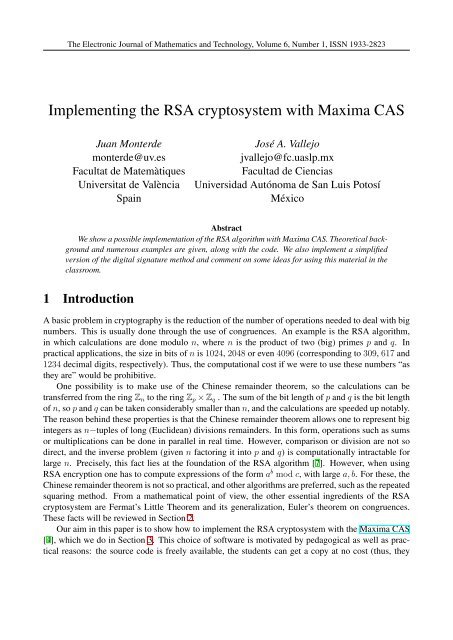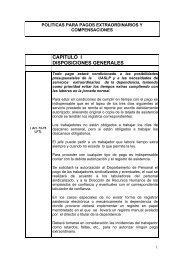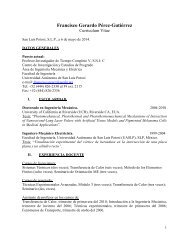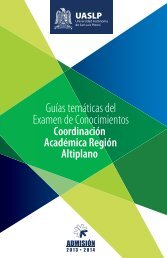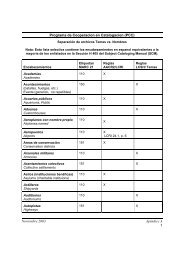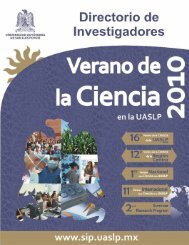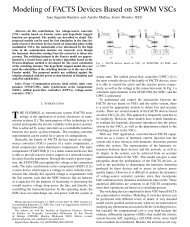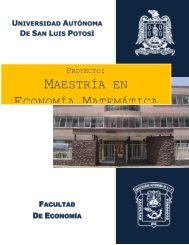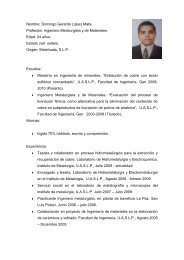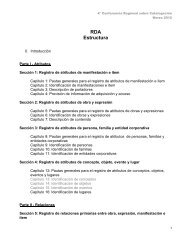Implementing the RSA cryptosystem with Maxima CAS - Facultad de ...
Implementing the RSA cryptosystem with Maxima CAS - Facultad de ...
Implementing the RSA cryptosystem with Maxima CAS - Facultad de ...
You also want an ePaper? Increase the reach of your titles
YUMPU automatically turns print PDFs into web optimized ePapers that Google loves.
The Electronic Journal of Ma<strong>the</strong>matics and Technology, Volume 6, Number 1, ISSN 1933-2823<strong>Implementing</strong> <strong>the</strong> <strong>RSA</strong> <strong>cryptosystem</strong> <strong>with</strong> <strong>Maxima</strong> <strong>CAS</strong>Juan Monter<strong>de</strong>monter<strong>de</strong>@uv.esFacultat <strong>de</strong> MatemàtiquesUniversitat <strong>de</strong> ValènciaSpainJosé A. Vallejojvallejo@fc.uaslp.mx<strong>Facultad</strong> <strong>de</strong> CienciasUniversidad Autónoma <strong>de</strong> San Luis PotosíMéxicoAbstractWe show a possible implementation of <strong>the</strong> <strong>RSA</strong> algorithm <strong>with</strong> <strong>Maxima</strong> <strong>CAS</strong>. Theoretical backgroundand numerous examples are given, along <strong>with</strong> <strong>the</strong> co<strong>de</strong>. We also implement a simplifiedversion of <strong>the</strong> digital signature method and comment on some i<strong>de</strong>as for using this material in <strong>the</strong>classroom.1 IntroductionA basic problem in cryptography is <strong>the</strong> reduction of <strong>the</strong> number of operations nee<strong>de</strong>d to <strong>de</strong>al <strong>with</strong> bignumbers. This is usually done through <strong>the</strong> use of congruences. An example is <strong>the</strong> <strong>RSA</strong> algorithm,in which calculations are done modulo n, where n is <strong>the</strong> product of two (big) primes p and q. Inpractical applications, <strong>the</strong> size in bits of n is 1024, 2048 or even 4096 (corresponding to 309, 617 and1234 <strong>de</strong>cimal digits, respectively). Thus, <strong>the</strong> computational cost if we were to use <strong>the</strong>se numbers “as<strong>the</strong>y are” would be prohibitive.One possibility is to make use of <strong>the</strong> Chinese remain<strong>de</strong>r <strong>the</strong>orem, so <strong>the</strong> calculations can betransferred from <strong>the</strong> ring Z n to <strong>the</strong> ring Z p × Z q . The sum of <strong>the</strong> bit length of p and q is <strong>the</strong> bit lengthof n, so p and q can be taken consi<strong>de</strong>rably smaller than n, and <strong>the</strong> calculations are spee<strong>de</strong>d up notably.The reason behind <strong>the</strong>se properties is that <strong>the</strong> Chinese remain<strong>de</strong>r <strong>the</strong>orem allows one to represent bigintegers as n−tuples of long (Eucli<strong>de</strong>an) divisions remain<strong>de</strong>rs. In this form, operations such as sumsor multiplications can be done in parallel in real time. However, comparison or division are not sodirect, and <strong>the</strong> inverse problem (given n factoring it into p and q) is computationally intractable forlarge n. Precisely, this fact lies at <strong>the</strong> foundation of <strong>the</strong> <strong>RSA</strong> algorithm [7]. However, when using<strong>RSA</strong> encryption one has to compute expressions of <strong>the</strong> form a b mod c, <strong>with</strong> large a, b. For <strong>the</strong>se, <strong>the</strong>Chinese remain<strong>de</strong>r <strong>the</strong>orem is not so practical, and o<strong>the</strong>r algorithms are preferred, such as <strong>the</strong> repeatedsquaring method. From a ma<strong>the</strong>matical point of view, <strong>the</strong> o<strong>the</strong>r essential ingredients of <strong>the</strong> <strong>RSA</strong><strong>cryptosystem</strong> are Fermat’s Little Theorem and its generalization, Euler’s <strong>the</strong>orem on congruences.These facts will be reviewed in Section 2.Our aim in this paper is to show how to implement <strong>the</strong> <strong>RSA</strong> <strong>cryptosystem</strong> <strong>with</strong> <strong>the</strong> <strong>Maxima</strong> <strong>CAS</strong>[4], which we do in Section 3. This choice of software is motivated by pedagogical as well as practicalreasons: <strong>the</strong> source co<strong>de</strong> is freely available, <strong>the</strong> stu<strong>de</strong>nts can get a copy at no cost (thus, <strong>the</strong>y
The Electronic Journal of Ma<strong>the</strong>matics and Technology, Volume 6, Number 1, ISSN 1933-2823can work at home <strong>with</strong> <strong>the</strong> same program <strong>the</strong>y use at <strong>the</strong> classroom), <strong>the</strong> <strong>de</strong>velopers are very activeand accessible, and <strong>the</strong> commands and syntax are very intuitive (some of <strong>the</strong> <strong>Maxima</strong> syntaxis merely a translation of <strong>the</strong> plain English used to <strong>de</strong>scribe <strong>the</strong> ma<strong>the</strong>matical operations, such asintegrate(xˆ2,x,0,1): “integrate x 2 <strong>with</strong> respect to x between 0 and 1”). These reasons almostcoinci<strong>de</strong> <strong>with</strong> <strong>the</strong> ones expressed by A. McAndrew in [5], a paper which <strong>de</strong>scribes in great <strong>de</strong>tail<strong>the</strong> use of <strong>Maxima</strong> and Axiom in teaching a course on cryptography (for an interesting alternative, seealso [6], where SAGE is used instead of <strong>Maxima</strong>). In<strong>de</strong>ed, <strong>the</strong> present paper is based on a 10−hoursummer course given by one of <strong>the</strong> authors (JM) to stu<strong>de</strong>nts of ma<strong>the</strong>matics, physics and engineering,ranging from first-year to post-graduates. Our conclusions are also similar to those of McAndrew in[5] (<strong>Maxima</strong> is particularly well suited for basic cryptography), so we refer to his paper for a justificationof <strong>the</strong> educational aspects and focus our attention on <strong>the</strong> technical <strong>de</strong>tails: <strong>the</strong> ma<strong>the</strong>maticalfoundation of <strong>the</strong> <strong>RSA</strong> <strong>cryptosystem</strong> and its practical implementation on <strong>Maxima</strong>.In Section 4 we show how to apply <strong>the</strong> <strong>RSA</strong> techniques to guarantee <strong>the</strong> authorship of a message,through <strong>the</strong> use of digital signatures. We inclu<strong>de</strong> sample co<strong>de</strong>s for all <strong>the</strong> functions <strong>de</strong>scribedin <strong>the</strong> text along <strong>with</strong> examples of <strong>the</strong>ir usage, so <strong>the</strong> paper is relatively self-contained. Informationabout <strong>the</strong> use of <strong>Maxima</strong> can be found in <strong>the</strong> page http://maxima.sourceforge.net/documentation.html.Section 5 offers some comments about how to use <strong>the</strong> present material in actual cryptographycourses.Some technical <strong>de</strong>tails about <strong>the</strong> software used:The version of <strong>Maxima</strong> was 5.24.0, <strong>with</strong> <strong>the</strong> interface wx<strong>Maxima</strong> (version 11.04.0). Both canbe downloa<strong>de</strong>d for free from http://maxima.sourceforge.net/download.html andhttp://andrejv.github.com/wxmaxima, respectively.The co<strong>de</strong> examples assume that <strong>the</strong> messages are written in pure ASCII (not exten<strong>de</strong>d), to avoidsome problems <strong>with</strong> <strong>the</strong> XML ren<strong>de</strong>ring of non printable characters in wx<strong>Maxima</strong>. When expressing<strong>the</strong> path to a file, we assume that <strong>the</strong> user has a Linux R○ or Mac OSX R○ system. For MS Windows R○ ,little changes are required.The source co<strong>de</strong> for <strong>the</strong> programs presented in this paper, suppressed outputs and some relatedmaterial, can be found at http://galia.fc.uaslp.mx/˜jvallejo/Software.html.2 Algebraic preliminaries2.1 Modular arithmeticWe begin by recalling Euclid’s algorithm. To compute <strong>the</strong> greatest common divisor (gcd) of twointegers a, b ∈ Z, first divi<strong>de</strong> a by b to find <strong>the</strong> quotient q 1 and <strong>the</strong> remain<strong>de</strong>r r 1 :a = q 1 · b + r 1 .Then, repeat <strong>the</strong> process substituting a by b and b by r 1 :Repeat again, this time using r 1 and r 2 , to find:b = q 2 · r 1 + r 2 .r 1 = q 3 · r 2 + r 3 .35
The Electronic Journal of Ma<strong>the</strong>matics and Technology, Volume 6, Number 1, ISSN 1933-2823The algorithm continues this way until one of <strong>the</strong> r i divi<strong>de</strong>s r i−1 . In this case, gcd(a, b) = r i−1 . Notethat <strong>the</strong> process ends after a finite number of steps, as in each one of <strong>the</strong>m we have r i < r i−1 .Example 1 To compute gcd(1547, 560), we proceed as follows:As 7|21, we are done: gcd(1547, 560) = 7.<strong>Maxima</strong> has a function to compute <strong>the</strong> gcd:1547 = 2 · 560 + 427;560 = 1 · 427 + 133;427 = 3 · 133 + 28;133 = 4 · 28 + 21;28 = 1 · 21 + 7.(%i1)gcd(1547,560);(%o1) 7A basic fact from Number Theory is <strong>the</strong> following: If d = gcd(a, b), <strong>with</strong> a > b, <strong>the</strong>re exist twointegers u, v such thatd = ua + vb.This is called <strong>the</strong> Bézout i<strong>de</strong>ntity (see [2], Section 1.2).Example 2 We have just seen that gcd(1547, 560) = 7. Let us find u, v such that 7 = u·1547+v·560.We can use <strong>the</strong> intermediate steps in Euclid’s algorithm, but reversing direction (from end to start):7 = 28 − 1 · 21= 28 − (133 − 4 · 28) = −133 + 5 · 28= −133 + 5 · (427 − 3 · 133) = 5 · 427 − 16 · 133= 5 · 427 − 16 · (560 − 427) = −16 · 560 + 21 · 427= −16 · 560 + 21 · (1547 − 2 · 560) = 21 · 1547 − 58 · 560.Thus,7 = 21 · 1547 − 58 · 560.The <strong>Maxima</strong> command gc<strong>de</strong>x does <strong>the</strong> same:(%i2)gc<strong>de</strong>x(1547,560);(%o2) [21, −58, 7]As a direct application of <strong>the</strong> Bézout i<strong>de</strong>ntity, we have that <strong>the</strong> invertible elements for <strong>the</strong> productin 1 Z/mZ, are precisely those coprimes <strong>with</strong> m. In o<strong>the</strong>r words: <strong>the</strong> integers a for which <strong>the</strong>re existsa b such that ab ≡ 1 (mod m), are precisely those a satisfying gcd(a, m) = 1.1 This is <strong>the</strong> ring formed by <strong>the</strong> equivalence classes <strong>de</strong>termined by <strong>the</strong> binary relation “congruence modulo m”: twointegers a, b ∈ Z are congruent modulo m iff <strong>the</strong>ir difference a−b is a multiple of m. In this case we write a ≡ b (mod m).36
The Electronic Journal of Ma<strong>the</strong>matics and Technology, Volume 6, Number 1, ISSN 1933-2823Example 3 Modulo 841, <strong>the</strong> integer 160 is invertible. In<strong>de</strong>ed, 841 = 29 2 while 160 = 2 5 · 5. Thus,gcd(841, 160) = 1. Its inverse is 205, since160 · 205 − 1 = 32800 − 1 = 32799 = 39 · 841.<strong>Maxima</strong> can compute <strong>the</strong> inverse of n modulo m directly <strong>with</strong> <strong>the</strong> command inv mod:(%i3)inv_mod(160,841);(%o3) 205The properties of modular arithmetic are similar to those of integer arithmetic. To name a few(see [1], Chapter 5):1. a ≡ a (mod m), for all a ∈ Z.2. a ≡ b (mod m) if and only if b ≡ a (mod m), for all a, b ∈ Z.3. If a ≡ b (mod m) and b ≡ c (mod m), <strong>the</strong>n a ≡ c (mod m), for all a, b, c ∈ Z.4. If a ≡ b (mod m) and c ≡ d (mod m), <strong>the</strong>n a + c ≡ b + d (mod m) and a · c ≡ b · d (mod m),for all a, b, c, d ∈ Z.5. If a ≡ b (mod m), <strong>the</strong>n if a ≡ b (mod d) for each divisor of m, d.6. If a ≡ b (mod m), and a ≡ b (mod n), <strong>with</strong> m, n coprimes, <strong>the</strong>n a ≡ b (mod m · n).We now recall a classical result (see [1], Chapter 5). Fermat’s Little Theorem says that if p is aprime number, <strong>the</strong>n for any integer a we haveand, for every integer a not divisible by p:a p ≡ a (mod p),a p−1 ≡ 1 (mod p). (1)An immediate consequence is <strong>the</strong> following. If a is not divisible by p and n ≡ m (mod (p − 1)), <strong>the</strong>na n ≡ a m (mod p).Example 4 Let us find <strong>the</strong> last digit of 2 1000000 when written in base 7. This is just <strong>the</strong> remain<strong>de</strong>rof 2 1000000 modulo 7. In or<strong>de</strong>r to apply <strong>the</strong> result above, we must reduce <strong>the</strong> exponent. If we takep = 7, n = 1000000, we must find a suitable m such that 1000000 ≡ m (mod 6). Since 1000000 =166666 · 6 + 4, this means that we can take m = 4. Applying now <strong>the</strong> corollary to Fermat’s LittleTheorem, we find2 1000000 ≡ 2 4 = 16 ≡ 2 (mod 7).Thus, <strong>the</strong> last digit of 2 1000000 when written in base 7 is 2.37
The Electronic Journal of Ma<strong>the</strong>matics and Technology, Volume 6, Number 1, ISSN 1933-28232.2 The Chinese remain<strong>de</strong>r <strong>the</strong>oremThe original form of <strong>the</strong> <strong>the</strong>orem, appearing in a book written by <strong>the</strong> Chinese ma<strong>the</strong>matician QinJiushao and published in 1247, is a result related to systems of congruences. It is possible to find aprece<strong>de</strong>nt in <strong>the</strong> Sunzi suanjing, a book from <strong>the</strong> third century written by Sun Zi:Han Xing asks how many soldiers are in his army. If you let <strong>the</strong>m para<strong>de</strong> in rows of 3soldiers, two soldiers will be left. If you let <strong>the</strong>m para<strong>de</strong> in rows of 5, 3 will be left, andin rows of 7, 2 will be left. How many soldiers are <strong>the</strong>re?.The mo<strong>de</strong>rn formulation of <strong>the</strong> problem is <strong>the</strong> following. Let m 1 , m 2 , ..., m k be integers that aregreater than one and pairwise coprime, and let a 1 , a 2 , ..., a k be any integers. Then <strong>the</strong>re exists aninteger x such that x ≡ a i (mod m i ) for each i ∈ {1, 2, ..., k}. Fur<strong>the</strong>rmore, for any o<strong>the</strong>r integer ythat satisfies all <strong>the</strong> congruences, y ≡ x (mod M) where M = m 1 · · · m k . Note that <strong>the</strong>re is only onesolution in {0, 1, ..., M}.The proof of <strong>the</strong> <strong>the</strong>orem (which can be found in Theorem 5.26 of [1]) gives an algorithm to findx. The following co<strong>de</strong> implements it in <strong>Maxima</strong> (it returns <strong>the</strong> lowest positive solution modulo M):Beginning of co<strong>de</strong>chinese_remain<strong>de</strong>r(a,k):=block([K,L,x],K:makelist(apply("*",<strong>de</strong>lete(k[i],k)),i,1,length(k)),L:makelist(first(gc<strong>de</strong>x(K[i],k[i])),i,1,length(k)),x:mod(sum(a[i]*K[i]*L[i],i,1,length(k)),apply("*",k)),x);End of co<strong>de</strong>To use it, just write chinese remain<strong>de</strong>r([a1,...,ar],[m1,...,mr]). For <strong>the</strong> HanXing’s example:(%i4)chinese_remain<strong>de</strong>r([2,3,2],[3,5,7]);(%o4) 23A small army, in<strong>de</strong>ed. Surely, this is one example in which <strong>the</strong> solution is not <strong>the</strong> one in {0, 1, ..., M}(as in this case Han Xing would have not nee<strong>de</strong>d to ask for <strong>the</strong> number of soldiers, being easy to count<strong>the</strong>m by himself), but one of <strong>the</strong> infinite numbers congruent <strong>with</strong> 23 modulo M = 7 · 5 · 3 = 105, thatis: 128, 233, etcetera.2.3 Euler’s <strong>the</strong>oremConsi<strong>de</strong>r Example 4 again. What if we are asked for <strong>the</strong> last digit in base 77?. We can not applyFermat’s <strong>the</strong>orem here, because 77 is composite. Euler found a generalization of Fermat’s <strong>the</strong>orem tothis case, introducing his totient function ϕ(n) (which gives <strong>the</strong> number of positive integers less than38
The Electronic Journal of Ma<strong>the</strong>matics and Technology, Volume 6, Number 1, ISSN 1933-2823or equal to n that are coprime to n).In <strong>Maxima</strong> we have <strong>the</strong> command totient:(%i5)totient(77);(%5) 60Now, Euler’s <strong>the</strong>orem says that for every a ∈ Z:a ϕ(n) ≡ 1 (mod n).Example 5 Let us compute <strong>the</strong> last digit of 2 1000000 in base 77. As ϕ(77) = 60, we know that2 60 ≡ 1 (mod 77). As 1000000 = 16666 · 60 + 40, <strong>the</strong>n 2 1000000 ≡ 2 40 (mod 77). Now, it is easy tocompute 2 40 (mod 77). For instance2 10 = 1024 = 13 · 77 + 23 ≡ 23 (mod 77),and 2 40 = 2 10·4 = 23 4 ≡ 23 (mod 77). Thus, <strong>the</strong> last digit of 2 1000000 in base 77 is 3.2.4 The <strong>Maxima</strong> function power modAs we have seen in Example 5, a basic computation one often encounters in modular arithmetic is<strong>the</strong> modular exponentiation when both <strong>the</strong> exponent and <strong>the</strong> modulus are very large. As mentioned,<strong>the</strong> Chinese remain<strong>de</strong>r <strong>the</strong>orem or <strong>the</strong> Euler’s <strong>the</strong>orem can be of some help to compute modular exponentiation.Never<strong>the</strong>less, <strong>the</strong>re is in <strong>Maxima</strong> a simple way to compute such exponentiation <strong>with</strong>outusing <strong>the</strong>se results.The modular power function power mod(a,b,c) gives exactly <strong>the</strong> result of a b (mod c) forb > 0:(%i6)(%o6) 23power_mod(2,40,77);However, power mod is much more efficient than <strong>the</strong> Chinese remain<strong>de</strong>r or Euler’s <strong>the</strong>orems,because it avoids generating <strong>the</strong> full form of a b . The algorithm to compute modular exponentiationfollows <strong>the</strong> repeated squaring method: Instead of repeated multiplication of a by itself, what this algorithmdoes is to reduce any partial result modulo c, immediately after a multiplication is performed.In that way we never encounter any integers greater than c 2 (see [8] for <strong>de</strong>tails on this method). In ourimplementation of <strong>the</strong> <strong>RSA</strong> <strong>cryptosystem</strong> we will use <strong>the</strong> power mod function, and so, <strong>the</strong> repeatedsquaring method implicitly.39
The Electronic Journal of Ma<strong>the</strong>matics and Technology, Volume 6, Number 1, ISSN 1933-28233 The <strong>RSA</strong> <strong>cryptosystem</strong>3.1 Caesar cipherThe first documented <strong>cryptosystem</strong> is very simple. It just replaces each letter in <strong>the</strong> plain text <strong>with</strong><strong>the</strong> one sitting three positions down <strong>the</strong> alphabet, for example, we would replace A by D, B by E, andso on (<strong>the</strong> last three letters, X, Y, Z, are replaced by A, B, C, respectively). It seems that this methodwas used by Julius Caesar to send military instructions to his generals.This i<strong>de</strong>a can be translated to numbers, for an easier use. If we replace each letter of <strong>the</strong> alphabetby a natural number (adding <strong>the</strong> space between words character) as ina b c d e f g h i j k l · · · r s t u v w x y z0 1 2 3 4 5 6 7 8 9 10 11 12 · · · 18 19 20 21 22 23 24 25 26<strong>the</strong>n <strong>the</strong> encryption function is simplyf(x) = x + 3 (mod 27),while <strong>the</strong> <strong>de</strong>cryption function is, obviously, <strong>the</strong> inverse:g(x) = f −1 (x) = x − 3 (mod 27).These simple properties make <strong>the</strong> Caesar cipher very easy to use. However, <strong>the</strong>y are also <strong>the</strong> origin ofits weakness. To break a <strong>cryptosystem</strong> means to <strong>de</strong>duce <strong>the</strong> encryption/<strong>de</strong>cryption functions from asample of ciphertext (<strong>the</strong> encrypted message); in this case, <strong>the</strong> method of attack is a simple frequencyanalysis of word repetitions (in English, for instance, <strong>the</strong> most repeated number corresponds to <strong>the</strong>most used letter, <strong>the</strong> e, <strong>the</strong> second is <strong>the</strong> t, and so on).Several schemes were <strong>de</strong>vised to improve <strong>the</strong> Caesar cipher. For instance, one could try morecomplicated bijections, such asf(x) = a · x + b (mod 27),<strong>with</strong> a an integer such that gcd(a, 27) = 1, and a, b ∈ {1, 2, ..., 26}. Ano<strong>the</strong>r possibility consistsin taking groups of contiguous letters, instead of one by one; for example, digraphs (groups of twoletters) or trigraphs (groups of three letters). In this case, an encryption function could have <strong>the</strong> formf(x) = a · x + b (mod m),where a, b ∈ {1, 2, ..., m − 1} and m is a number big enough to allow for <strong>the</strong> enumeration (in aone-to-one and onto manner) of every possible combination of three characters. Both parameters, aand m, are necessary for <strong>the</strong> encryption as well as <strong>the</strong> <strong>de</strong>cryption processes, and are called <strong>the</strong> key of<strong>the</strong> <strong>cryptosystem</strong>.Anyway, <strong>the</strong>se systems are too weak to be used in practice. They can be broken in a number ofways, very easily <strong>with</strong> <strong>the</strong> use of a mo<strong>de</strong>rn computer. We have cited <strong>the</strong>m here just for <strong>the</strong> sake ofillustration of <strong>the</strong> concepts involved.40
The Electronic Journal of Ma<strong>the</strong>matics and Technology, Volume 6, Number 1, ISSN 1933-28233.2 Public key <strong>cryptosystem</strong>sA revolution happened when <strong>the</strong> so called public key <strong>cryptosystem</strong>s appeared, in <strong>the</strong> late seventies.These systems are based on <strong>the</strong> following fact: <strong>the</strong>re are bijective (one-to-one and onto) functions forwhich <strong>the</strong> calculation of <strong>the</strong> inverse is very difficult, computationally impossible. Then, we can makepublicly available <strong>the</strong> keys used to encrypt messages whenever <strong>the</strong> keys used for <strong>de</strong>cryption are to befound by one of <strong>the</strong>se functions. One example is <strong>the</strong> factorization of a given number into a product ofprimes, and this fact is <strong>the</strong> foundation of <strong>the</strong> <strong>RSA</strong> method (see [7]).In a public key <strong>cryptosystem</strong>, each user has a public key, that is, an encryption function f pub , anda private key, a <strong>de</strong>cryption function f pri , which are inverses one of ano<strong>the</strong>r: f pri = f −1pub. Thus, ifa user A wants to send a message (say, “text”, translated to numbers as in <strong>the</strong> preceding section to“2052420”) to a user B, she must look in <strong>the</strong> public keys listing <strong>the</strong> one corresponding to B (say,fpub B ), apply it to <strong>the</strong> message (obtaining f pub B (2052420)), and send it to B. Even in <strong>the</strong> unfortunateevent that someone intercepts <strong>the</strong> ciphered text, only B knows <strong>the</strong> <strong>de</strong>cryption function. In<strong>de</strong>ed, userB can read <strong>the</strong> original message by just applying fpri B = ( fpub) B −1to fBpub (2052420); thus:3.3 The <strong>RSA</strong> algorithmf B pri(fBpub (2052420) ) = ( f B pub) −1 (fBpub (2052420) ) = 2052420.As stated in <strong>the</strong> preceding subsection, to implement <strong>the</strong> <strong>RSA</strong> <strong>cryptosystem</strong> we only need to give <strong>the</strong>pair of functions (f pub , f pri ) for each user, A, of <strong>the</strong> system. The procedure is <strong>the</strong> following:1. User A chooses two large prime numbers, p A and q A .2. Calculate <strong>the</strong> product n A = p A · q A .3. Evaluate <strong>the</strong> totient function 2 on n A , Φ(n A )4. Choose a number e A ∈ {1, 2, ..., Φ(n A )}, coprime <strong>with</strong> Φ(n A ).With <strong>the</strong>se choices, gcd(e A , Φ(n A )) = 1, so e A is an invertible element of <strong>the</strong> ring Z/Φ(n A )Z. Letd A be an integer such that its equivalence class is <strong>the</strong> inverse of that of e A , that is,e A · d A ≡ 1 (mod Φ(n A )).5. The encryption function, f A pub : Z/n AZ → Z/n A Z, is given byf A pub(m) = m e A(mod n A ).2 Note that in this case, <strong>with</strong> n A semiprime (that is, <strong>the</strong> product of two primes), we haveΦ(n A ) = (p A − 1) · (q A − 1) = n A − p A − q A − 1.41
The Electronic Journal of Ma<strong>the</strong>matics and Technology, Volume 6, Number 1, ISSN 1933-28236. The <strong>de</strong>cryption function, fpri, A is <strong>the</strong> inverse of fpub A , that is:f A pri(m) = m d A(mod n A ).It is instructive to check that <strong>the</strong>se functions are in<strong>de</strong>ed inverses of each o<strong>the</strong>r.Theorem 6 For every m ∈ Z/n A Z,f A pri(f A pub(m)) ≡ f A pri(m e A) ≡ m e A·d A≡ m (mod n A ).Proof. For simplicity, we will drop <strong>the</strong> subscripts A. We can assume that m is not divisible 3 by p.Then, by Fermat’s Little Theorem (1),m p−1 ≡ 1 (mod p).Let us take <strong>the</strong> power of q − 1 on both si<strong>de</strong>s of this equation:m (p−1)·(q−1) = ( m p−1) q−1≡ 1 q−1 = 1 (mod p).A similar computation, interchanging p and q, givesm (p−1)·(q−1) = ( m q−1) p−1≡ 1 p−1 = 1 (mod q).We can apply <strong>the</strong> property 6 of modular arithmetic, to getNote that for any integer k we will also havem (p−1)·(q−1) = 1 (mod pq).m k·(p−1)·(q−1) = ( m (p−1)·(q−1)) k≡ 1 k = 1 (mod pq).Now, recall that e · d ≡ 1 (mod Φ(n) = (p − 1) · (q − 1)). That meansThus:e · d = 1 + k · (p − 1) · (q − 1).m e·d = m 1+k·(p−1)·(q−1) = m · m k·(p−1)·(q−1) ≡ m · 1 = m (mod pq),so m e·d ≡ m (mod n), as we inten<strong>de</strong>d to prove.Why is this method secure?. In <strong>the</strong> <strong>RSA</strong> <strong>cryptosystem</strong>, <strong>the</strong> public key of user A is <strong>the</strong> pair ofintegers (e A , n A ), while her private key is <strong>the</strong> pair (d A , n A ). To find <strong>the</strong> private key knowing <strong>the</strong>public key is equivalent to computing <strong>the</strong> integer d A knowing e A and n A . Thus, if we want to break<strong>the</strong> <strong>cryptosystem</strong>, we must first calculate Φ(n A ) = (p A − 1)(q A − 1), that is, we must factor n A as <strong>the</strong>product of two primes. This is an extremely difficult problem from <strong>the</strong> computational point of view;in<strong>de</strong>ed, a joint effort of several researchers using hundreds of <strong>de</strong>dicated computers only could factora 232−digit number after two years of computation (see [3]). Note that this number corresponds toa 768−bit encryption, <strong>the</strong> problem of factoring a 1024−bit key is a thousand times har<strong>de</strong>r! Thus,although breaking <strong>the</strong> <strong>RSA</strong> <strong>cryptosystem</strong> is <strong>the</strong>oretically possible, it is practically impossible <strong>with</strong>our current state of knowledge.3 That p divi<strong>de</strong> m is highly improbable, given <strong>the</strong> magnitu<strong>de</strong> or<strong>de</strong>r of <strong>the</strong> prime p.42
The Electronic Journal of Ma<strong>the</strong>matics and Technology, Volume 6, Number 1, ISSN 1933-28233.4 Implementation in <strong>Maxima</strong> <strong>CAS</strong>The following function generates a list (e, n, d) suitable for use in <strong>the</strong> <strong>RSA</strong> algorithm.(load(distrib));Beginning of co<strong>de</strong>generate_random_key(l):=block([p,q,n,r,e,d,K],p:next_prime(floor(float(random_continuous_uniform(2ˆl,2ˆ(l+1))))),q:next_prime(floor(float(random_continuous_uniform(2ˆl,2ˆ(l+1))))),n:p*q,r:(p-1)*(q-1),e:next_prime(floor(float(random(floor(r/2))))),d:inv_mod(e,r),K:[e,n,d],K);End of co<strong>de</strong>To use it write generate random key(l) where l <strong>de</strong>termines <strong>the</strong> number of digits of <strong>the</strong>integers e, n, d (<strong>the</strong>y will be pseudo-randomly generated between 2 l and 2 l+1 ). A suggested value(to speed up computations while keeping practical interest for applications) is l = 125. Note that<strong>the</strong> construction of e is based on <strong>the</strong> obvious consequence of <strong>the</strong> Prime Number Theorem 4 that <strong>the</strong>number of primes between r/2 and r (for large r) is approximately r/log(r/2), so <strong>the</strong>se are relativelyabundant.For example:(%i7)key:generate_random_key(125);(%o7) [671258217454686505293403265373669737061769832160804966205145423006710890659,6524380046621073928456206976859918286968722163998541593398840097117692758107,4117416708352497196549341588732382167090260042357291528574523538009688319619]Once we have <strong>the</strong> list (e, n, d) as <strong>the</strong> output of generate random key, we can create our publickey (e, n):(%i8)public_key:rest(key,-1);(%o8) [671258217454686505293403265373669737061769832160804966205145423006710890659,that4 Let π(x) be <strong>the</strong> function giving <strong>the</strong> number of primes less than or equal to x. Then, <strong>the</strong> Prime Number Theorem sayslimx→+∞π(x)x/ln(x) = 1.43
The Electronic Journal of Ma<strong>the</strong>matics and Technology, Volume 6, Number 1, ISSN 1933-28236524380046621073928456206976859918286968722163998541593398840097117692758107]and our private key (d, n):(%i9)private_key:reverse(rest(key,1));(%o9) [4117416708352497196549341588732382167090260042357291528574523538009688319619,6524380046621073928456206976859918286968722163998541593398840097117692758107]The next function rsa encrypt reads a text from a file and encrypts it in blocks of length k.(load(stringproc));Beginning of co<strong>de</strong>file_to_string(u):=block([a,i:0,text_string,tmp],a:openr(u),while stringp(tmp[i]:readline(a)) do i:i+1,text_string:simplo<strong>de</strong>(makelist(tmp[j],j,0,i-1)," "),text_string);rsa_encrypt_console(s,k,P):=block([tmp,ad<strong>de</strong>d_char,encrypted_text,encrypted_text_ad<strong>de</strong>d],local(fill_string,string_to_number,rsa_enco<strong>de</strong>),tmp:smake(k-(slength(s)-k*floor(slength(s)/k)),ascii(126)),ad<strong>de</strong>d_char:[slength(tmp)],fill_string(s,k):=concat(s,tmp),string_to_number(s):=sum((cint(charat(s,i))-32)*95ˆ(i-1),i,1,slength(s)),rsa_enco<strong>de</strong>(a,b,c):=power_mod(a,b,c),encrypted_text:makelist(rsa_enco<strong>de</strong>(string_to_number(substring(fill_string(s,k), 1+k*(i-1), 1+k*i)),P[1],P[2]), i, 1, slength(fill_string(s,k))/k),encrypted_text_ad<strong>de</strong>d:append(ad<strong>de</strong>d_char,encrypted_text));rsa_encrypt_file(s,k,P,p):=block([LL],LL:rsa_encrypt_console(s,k,P),44
The Electronic Journal of Ma<strong>the</strong>matics and Technology, Volume 6, Number 1, ISSN 1933-2823);stringout(p,LL)rsa_encrypt(q,k,P,[p]):=block([t],t:file_to_string(q),if p=[] <strong>the</strong>n rsa_encrypt_console(t,k,P)else rsa_encrypt_file(t,k,P,first(p)));End of co<strong>de</strong>The result can be shown in <strong>the</strong> console or, if a path to a file is given, written to that file. For <strong>the</strong>purpose of this example, we have stored <strong>the</strong> following text in /root/hysteria.txt:As she laughed I was aware of becoming involved in her laughter and being part of it,until her teeth were only acci<strong>de</strong>ntal stars <strong>with</strong> a talent for squad-drill. I was drawn in byshort gasps, inhaled at each momentary recovery, lost finally in <strong>the</strong> dark caverns of herthroat, bruised by <strong>the</strong> ripple of unseen muscles. An el<strong>de</strong>rly waiter <strong>with</strong> trembling handswas hurriedly spreading a pink and white checked cloth over <strong>the</strong> rusty green iron table,saying: ”If <strong>the</strong> lady and gentleman wish to take <strong>the</strong>ir tea in <strong>the</strong> gar<strong>de</strong>n, if <strong>the</strong> lady andgentleman wish to take <strong>the</strong>ir tea in <strong>the</strong> gar<strong>de</strong>n ...” I <strong>de</strong>ci<strong>de</strong>d that if <strong>the</strong> shaking of herbreasts could be stopped, some of <strong>the</strong> fragments of <strong>the</strong> afternoon might be collected, andI concentrated my attention <strong>with</strong> careful subtlety to this end.We can encrypt <strong>the</strong> text in blocks of length 5 k = 20 <strong>with</strong> <strong>the</strong> following commands (<strong>the</strong> output issuppressed because of its length):(%i10) load(rsa_encrypt)$(%i11) rsa_encrypt("/root/hysteria.txt",20,public_key);Or we can redirect <strong>the</strong> output to a file, in this example /root/hysteria-encrypted.txt:(%i12) rsa_encrypt("/root/hysteria.txt",20,public_key,"/root/hysteria-encrypted.txt");(%o12) /root/hysteria − encrypted.txtThe function given below, rsa <strong>de</strong>crypt, reads encrypted text from a file and <strong>de</strong>crypts it.(load(basic));Beginning of co<strong>de</strong>5 Here, <strong>the</strong> particular value k = 20 is chosen just as an example. In Section 5, k = 3 is taken instead. What one shouldkeep in mind when choosing <strong>the</strong> value of k is that <strong>the</strong> numerical representation of each block must have a value less than<strong>the</strong> modulus if <strong>the</strong> message is to be <strong>de</strong>crypted successfully.45
The Electronic Journal of Ma<strong>the</strong>matics and Technology, Volume 6, Number 1, ISSN 1933-2823rsa_<strong>de</strong>crypt_console(M,k,Q):=block([clean_message],local(number_to_string,rsa_<strong>de</strong>co<strong>de</strong>),number_to_string(z,k):=makelist(ascii(mod(floor(z/(95ˆ(i-1))),95)+32),i,1,k),rsa_<strong>de</strong>co<strong>de</strong>(a,b,c):=power_mod(a,b,c),clean_message:simplo<strong>de</strong>(makelist(simplo<strong>de</strong>(number_to_string(rsa_<strong>de</strong>co<strong>de</strong>(M[i],Q[1],Q[2]),k)),i,1,length(M))),clean_message);rsa_<strong>de</strong>crypt(s,k,Q,[p]):=block([prelist,AA,BB,len],prelist:read_list(s,comma),AA:rest(rest(prelist,-2),1),BB:pop(AA),len:slength(rsa_<strong>de</strong>crypt_console(AA,k,Q)),if p=[] <strong>the</strong>nsubstring(rsa_<strong>de</strong>crypt_console(AA,k,Q),1,len-(BB-1))elsestringout(first(p),substring(rsa_<strong>de</strong>crypt_console(AA,k,Q),1,len-(BB-1))));End of co<strong>de</strong>Again, <strong>the</strong> function can show <strong>the</strong> clean text in <strong>the</strong> console or, if a path to a file is given, to store<strong>the</strong> <strong>de</strong>crypted text in that file. In <strong>the</strong> example, we <strong>de</strong>co<strong>de</strong> <strong>the</strong> text that was previously encrypted andstored in /root/hysteria-encrypted.txt. Note also that <strong>the</strong> length of <strong>the</strong> blocks (k = 20)is passed as an argument:(%i13) rsa_<strong>de</strong>crypt("/root/hysteria-encrypted.txt",20,private_key);(%o13) As she laughed I was aware of becoming involved in her laughter and being part of it, untilher teeth were only acci<strong>de</strong>ntal stars <strong>with</strong> a talent for squad-drill. I was drawn in by short gasps, inhaledat each momentary recovery, lost finally in <strong>the</strong> dark caverns of her throat, bruised by <strong>the</strong> rippleof unseen muscles. An el<strong>de</strong>rly waiter <strong>with</strong> trembling hands was hurriedly spreading a pink and whitechecked cloth over <strong>the</strong> rusty green iron table, saying: ”If <strong>the</strong> lady and gentleman wish to take <strong>the</strong>ir46
The Electronic Journal of Ma<strong>the</strong>matics and Technology, Volume 6, Number 1, ISSN 1933-2823tea in <strong>the</strong> gar<strong>de</strong>n, if <strong>the</strong> lady and gentleman wish to take <strong>the</strong>ir tea in <strong>the</strong> gar<strong>de</strong>n ...” I <strong>de</strong>ci<strong>de</strong>d that if <strong>the</strong>shaking of her breasts could be stopped, some of <strong>the</strong> fragments of <strong>the</strong> afternoon might be collected,and I concentrated my attention <strong>with</strong> careful subtlety to this end.To redirect <strong>the</strong> output to a file, we give <strong>the</strong> path to that file, as in:(%i14) rsa_<strong>de</strong>crypt("/root/hysteria-encrypted.txt",20,private_key,"/root/hysteria-<strong>de</strong>crypted.txt");(%o14) /root/hysteria − <strong>de</strong>crypted.txt4 Digital signaturesAlthough <strong>the</strong> <strong>RSA</strong> <strong>cryptosystem</strong>, as <strong>de</strong>scribed in <strong>the</strong> preceding sections, has some nice properties (itis reliable and secure), it also has a serious drawback: it does not provi<strong>de</strong> any method to check <strong>the</strong>au<strong>the</strong>nticity of <strong>the</strong> message; in o<strong>the</strong>r words, we do not know if <strong>the</strong> person claiming to be <strong>the</strong> sen<strong>de</strong>r of<strong>the</strong> message is actually that person, as <strong>the</strong> recipient gets <strong>the</strong> message encrypted <strong>with</strong> his own publickey, which is available to everybody.However, using <strong>the</strong> same i<strong>de</strong>as of <strong>the</strong> <strong>RSA</strong> method, a solution to this problem can be given. Itconsists in <strong>the</strong> following: <strong>the</strong> sen<strong>de</strong>r (user A) signs <strong>the</strong> message in such a way that anybody (forinstance, <strong>the</strong> receiver, user B) can <strong>de</strong>duce that only A is able to produce that signature. To implementthis “digital signature”, a possible method 6 follows <strong>the</strong>se steps: user A adds to <strong>the</strong> message she wantsto send (say text) her signature, ano<strong>the</strong>r piece of text such as I am user A, that i<strong>de</strong>ntifies her, encrypted<strong>with</strong> her private key, to get text + f A pri(I am user A). Then, <strong>the</strong> sen<strong>de</strong>r (user A) encrypts <strong>the</strong> result<strong>with</strong> <strong>the</strong> public key of <strong>the</strong> recipient B, f B pub (text + f A pri(I am user A)). When user B <strong>de</strong>crypts <strong>the</strong>message, he will find two pieces, <strong>the</strong> message text and <strong>the</strong> encrypted chunk f A pri(I am user A). To besure that <strong>the</strong> message actually comes from A, all he has to do is to apply her public key to it, as <strong>the</strong>result is <strong>the</strong>nf A pub(f A pri(I am user A)) = I am user A.Note that <strong>the</strong> i<strong>de</strong>a behind <strong>the</strong> digital signature is that only A is able to produce a text such that, whenapplying fpub A , <strong>the</strong> result is legible.The following function, rsa encrypt ds, is a slight modification of rsa encrypt capableof including a signature. It takes a file <strong>with</strong> path a containing some text to encrypt, an integer k (<strong>the</strong>chunk length), a list P = [e, n] (<strong>the</strong> public key of <strong>the</strong> recipient, user B), a list Q = [d, n] (<strong>the</strong> privatekey of <strong>the</strong> sen<strong>de</strong>r, user A), a path q to a file storing a signature, and, optionally, a path p to a file where<strong>the</strong> output is written as its arguments. When p is absent, <strong>the</strong> output is written in <strong>the</strong> <strong>Maxima</strong> console.load("stringproc");Beginning of co<strong>de</strong>6 The procedure we <strong>de</strong>scribe here is not <strong>the</strong> one used in an actual situation, where A first gets a digest of <strong>the</strong> message,<strong>with</strong> a certain hash function such as MD5, and <strong>the</strong>n encrypt this digest <strong>with</strong> her own private key. But <strong>the</strong> example we<strong>de</strong>scribe retains <strong>the</strong> basic i<strong>de</strong>a while being far more easy to implement.47
The Electronic Journal of Ma<strong>the</strong>matics and Technology, Volume 6, Number 1, ISSN 1933-2823load("basic");file_to_string(u):=block([a,i:0,tmp,text_string],a:openr(u),while stringp(tmp[i]:readline(a)) do i:i+1,text_string:simplo<strong>de</strong>(makelist(tmp[j],j,0,i-1)," "),text_string);rsa_encrypt_console(s,k,P):=block([tmp,ad<strong>de</strong>d_char,encrypted_text,encrypted_text_ad<strong>de</strong>d],local(fill_string,string_to_number,rsa_enco<strong>de</strong>),tmp:smake(k-(slength(s)-k*floor(slength(s)/k)),ascii(126)),ad<strong>de</strong>d_char:[slength(tmp)],fill_string(s,k):=concat(s,tmp),string_to_number(s):=sum((cint(charat(s,i))-32)*95ˆ(i-1),i,1,slength(s)),rsa_enco<strong>de</strong>(a,b,c):=power_mod(a,b,c),encrypted_text:makelist(rsa_enco<strong>de</strong>(string_to_number(substring(fill_string(s,k), 1+k*(i-1), 1+k*i)),P[1],P[2]), i, 1, slength(fill_string(s,k))/k),encrypted_text_ad<strong>de</strong>d:append(ad<strong>de</strong>d_char,encrypted_text));rsa_encrypt_ds(a,k,P,Q,q,[p]):=block([t,v,L,M,l,m,S],t:file_to_string(a),v:file_to_string(q),L:rsa_encrypt_console(t,k,P),M:rsa_encrypt_console(v,k,Q),l:length(L),m:length(M),S:[l,m,L,M],if p=[] <strong>the</strong>n Selse stringout(first(p),S));End of co<strong>de</strong>To use this function, we prepare a file /root/signature.txt, <strong>with</strong> <strong>the</strong> following content:T. S. EliotPrufrock and O<strong>the</strong>r Observations191748
The Electronic Journal of Ma<strong>the</strong>matics and Technology, Volume 6, Number 1, ISSN 1933-2823Then we can make <strong>the</strong> following to encrypt and sign <strong>the</strong> file /root/hysteria.txt using <strong>the</strong>following public-private keys for users A and B:(%i15) public_keyA;(%o15) [1650059172879816791260876129953328603907602666352067869083685909461393736909,3708150289863286994535783817852033198889096484604423097296248436592325166991](%i16) private_keyA;(%o16) [379527932593144827812732692164393824004791535303438931019254825655253733685,3708150289863286994535783817852033198889096484604423097296248436592325166991](%i17) public_keyB;(%o17) [146879466713946901827530582303760087656241476871443053164266198403926458463,3040216715027414087962274325454256602848802215847097074502322427275375547837](%i18) private_keyB;(%o18) [2843378208968070601455100396976753790872008736270032956043745072607798170907,3040216715027414087962274325454256602848802215847097074502322427275375547837](%i19) rsa_encrypt_ds("/root/hysteria.txt",20,public_keyB,private_keyA,"/root/signature.txt")$(The output here was suppressed, it can be seen at http://galia.fc.uaslp.mx/˜jvallejo/Software.html). Or, we can redirect <strong>the</strong> output to a file, as before. In this example, <strong>the</strong> file is/root/hysteria-signed.txt:(%i20) rsa_encrypt_ds("/root/hysteria.txt",20,public_keyB,private_keyA,"/root/signature.txt","/root/hysteria-signed.txt");(%o20) /root/hysteria − signed.txtTo <strong>de</strong>crypt <strong>the</strong> file and <strong>the</strong> signature, we have <strong>the</strong> following function, rsa <strong>de</strong>crypt ds:(load(stringproc));Beginning of co<strong>de</strong>rsa_<strong>de</strong>crypt_console(M,k,T):=block([clean_message],local(number_to_string,rsa_<strong>de</strong>co<strong>de</strong>),number_to_string(z,k):=makelist(ascii(mod(floor(z/(95ˆ(i-1))),95)+32),i,1,k),rsa_<strong>de</strong>co<strong>de</strong>(a,b,c):=power_mod(a,b,c),49
The Electronic Journal of Ma<strong>the</strong>matics and Technology, Volume 6, Number 1, ISSN 1933-2823);clean_message:simplo<strong>de</strong>(makelist(simplo<strong>de</strong>(number_to_string(rsa_<strong>de</strong>co<strong>de</strong>(M[i],T[1],T[2]),k)),i,1,length(M))),clean_messagersa_<strong>de</strong>crypt_ds(s,k,y,z,[p]):=block([prelist,ML,SL,BB,CC,lenm,lens],prelist:read_list(s,comma),ML:rest(rest(prelist,-prelist[3]-5),4),SL:rest(rest(prelist,-3),prelist[2]+6),BB:pop(ML),CC:pop(SL),lenm:slength(rsa_<strong>de</strong>crypt_console(ML,k,z)),lens:slength(rsa_<strong>de</strong>crypt_console(SL,k,y)),if p=[] <strong>the</strong>nsimplo<strong>de</strong>([substring(rsa_<strong>de</strong>crypt_console(ML,k,z),1,lenm-(BB-1)),"--- Signature begins ---",substring(rsa_<strong>de</strong>crypt_console(SL,k,y),1,lens-(CC-1))]," ")elsestringout(first(p), simplo<strong>de</strong>([substring(rsa_<strong>de</strong>crypt_console(ML,k,z),1,lenm-(BB-1)),"--- Signature begins ---",substring(rsa_<strong>de</strong>crypt_console(SL,k,y),1,lens-(CC-1))]," ")));End of co<strong>de</strong>Applying it to <strong>the</strong> output of <strong>the</strong> function rsa encrypt ds, we have:(%i21) rsa_<strong>de</strong>crypt_ds("/root/hysteria-signed.txt",20,public_keyA,private_keyB);(%o21) As she laughed I was aware of becoming involved in her laughter and being part of it, untilher teeth were only acci<strong>de</strong>ntal stars <strong>with</strong> a talent for squad-drill. I was drawn in by short gasps,inhaled at each momentary recovery, lost finally in <strong>the</strong> dark caverns of her throat, bruised by <strong>the</strong>ripple of unseen muscles. An el<strong>de</strong>rly waiter <strong>with</strong> trembling hands was hurriedly spreading a pink andwhite checked cloth over <strong>the</strong> rusty green iron table, saying: ”If <strong>the</strong> lady and gentleman wish to take<strong>the</strong>ir tea in <strong>the</strong> gar<strong>de</strong>n, if <strong>the</strong> lady and gentleman wish to take <strong>the</strong>ir tea in <strong>the</strong> gar<strong>de</strong>n ...” I <strong>de</strong>ci<strong>de</strong>dthat if <strong>the</strong> shaking of her breasts could be stopped, some of <strong>the</strong> fragments of <strong>the</strong> afternoon might becollected, and I concentrated my attention <strong>with</strong> careful subtlety to this end. — Signature begins — T.S. Eliot Prufrock and O<strong>the</strong>r Observations 1917Of course, we can redirect <strong>the</strong> output to a file, instead than <strong>the</strong> console:50
The Electronic Journal of Ma<strong>the</strong>matics and Technology, Volume 6, Number 1, ISSN 1933-2823(%i22) rsa_<strong>de</strong>crypt_ds("/root/hysteria-signed.txt",20,public_keyA,private_keyB,"hysteria-signed-<strong>de</strong>crypted.txt");(%o22) /root/hysteria − signed − <strong>de</strong>crypted.txtNote that in or<strong>de</strong>r to get <strong>the</strong> text in <strong>the</strong> file /root/hysteria-signed-<strong>de</strong>crypted.txtnicely formatted, one has to write <strong>the</strong> co<strong>de</strong> above for rsa encrypt ds <strong>with</strong> <strong>the</strong> appropriate newline breaks and long line expressions, as it contains some string arguments in simplo<strong>de</strong> that willbe written “as <strong>the</strong>y are”; <strong>the</strong> version appearing here does not have <strong>the</strong>se features to fit <strong>with</strong>in <strong>the</strong> pagewidth.5 Working at <strong>the</strong> classroomWhen working out examples <strong>with</strong> <strong>the</strong> stu<strong>de</strong>nts at <strong>the</strong> classroom, <strong>the</strong> teacher can produce a message,sign it and send it encrypted to <strong>the</strong> stu<strong>de</strong>nts for <strong>de</strong>crypting it. To do this efficiently, it is a goodi<strong>de</strong>a to have a file <strong>with</strong> <strong>the</strong> names of <strong>the</strong> stu<strong>de</strong>nts or<strong>de</strong>red (following any criteria), and ano<strong>the</strong>r onewhere <strong>the</strong>ir public keys are stored <strong>with</strong> <strong>the</strong> same or<strong>de</strong>ring. In this way, <strong>the</strong> teacher can send <strong>the</strong> samemessage to different stu<strong>de</strong>nts, digitally signed <strong>with</strong> his own private key, but encrypted <strong>with</strong> <strong>the</strong> publickey corresponding to each stu<strong>de</strong>nt.Suppose for example that we have seven stu<strong>de</strong>nts: Cor<strong>de</strong>lia, Curan, Edmund, Fool, Goneril, Lear,and Regan. We create a text file <strong>with</strong> each name in one line, alphabetically or<strong>de</strong>red, and store it at/root/stu<strong>de</strong>nts.txt. Also, we let <strong>the</strong> stu<strong>de</strong>nts create <strong>the</strong>ir own public-private keys, and ask<strong>the</strong>m to hand us <strong>the</strong> public pairs. All <strong>the</strong>se public pairs are written on ano<strong>the</strong>r text file, each pair e, nin one line (separated by commas). For instance, we could have:1119871,3560093623521,2735539745231,25439871321063,3038941140759,19812111019747,2155823609043,2827757We store <strong>the</strong> file at /root/public-keys.txt. For later use, note that <strong>the</strong> public key of <strong>the</strong>fourth stu<strong>de</strong>nt, Fool, is [1321063, 3038941]. Actually, his private one is [734395, 3038941] (both weregenerated <strong>with</strong> generate random key(10)).The teacher wants to send an encrypted message, contained in <strong>the</strong> file /root/KingLear.txt.His own digital signature:The teacherWilliam ShakespeareKing Learis contained in ano<strong>the</strong>r file, /root/digsig.txt. Finally, <strong>the</strong> public-private keys of <strong>the</strong> teacherare:51
The Electronic Journal of Ma<strong>the</strong>matics and Technology, Volume 6, Number 1, ISSN 1933-2823(%i23) teacher_public;(%o23) [429881, 2294543](%i24) teacher_private;(%o24) [872729, 2294543]With <strong>the</strong>se data, <strong>the</strong> following function rsa encrypt group signs <strong>the</strong> message <strong>with</strong> <strong>the</strong> teacher’ssignature, encrypts <strong>the</strong> signature <strong>with</strong> <strong>the</strong> teacher’s private key, <strong>the</strong> whole message <strong>with</strong> each stu<strong>de</strong>nt’spublic key and generates a file <strong>with</strong> <strong>the</strong> name of <strong>the</strong> stu<strong>de</strong>nt containing <strong>the</strong> encrypted message, storedin a path given by <strong>the</strong> user (in <strong>the</strong> example, /root/messages/). Note also <strong>the</strong> k value for <strong>the</strong> textchunks (k = 3 in <strong>the</strong> example).(load(numericalio));Beginning of co<strong>de</strong>rsa_encrypt_group(s,k,t,u,r,Q,q):=block([stu<strong>de</strong>nts,publickeys,name,path],stu<strong>de</strong>nts:read_list(t),publickeys:read_nested_list(u,comma),for j:1 thru length(stu<strong>de</strong>nts) do(name:stu<strong>de</strong>nts[j],path:simplo<strong>de</strong>([r,string(name),".txt"]),rsa_encrypt_ds(s,k,publickeys[j],Q,q,path)));End of co<strong>de</strong>(%i25) rsa_encrypt_group("/root/KingLear.txt",3,"/root/stu<strong>de</strong>nts.txt","/root/public-keys.txt","/root/messages/",teacher_private,"/root/digsig.txt");(%o25) doneNow, we have seven files in /root/messages/. These are: Cor<strong>de</strong>lia.txt, Curan.txt,Edmund.txt, Fool.txt, Goneril.txt, Lear.txt, and Regan.txt. Suppose that <strong>the</strong>teacher sends each one to its corresponding recipient. When Fool receives his message, he can <strong>de</strong>cryptit using <strong>the</strong> function rsa <strong>de</strong>crypt ds of <strong>the</strong> preceding section, as he knows <strong>the</strong> teacher’s publickey (to <strong>de</strong>cipher <strong>the</strong> signature) and his own private key (to <strong>de</strong>cipher <strong>the</strong> message):(%i26) rsa_<strong>de</strong>crypt_ds("/root/messages/Fool.txt",3,teacher_public,[734395,3038941]);52
The Electronic Journal of Ma<strong>the</strong>matics and Technology, Volume 6, Number 1, ISSN 1933-2823(%o26) This is <strong>the</strong> excellent foppery of <strong>the</strong> world, that, when we are sick in fortune,–often <strong>the</strong> surfeitof our own behavior,–we make guilty of our disasters <strong>the</strong> sun, <strong>the</strong> moon, and <strong>the</strong> stars: as if we werevillains by necessity; fools by heavenly compulsion; knaves, thieves, and treachers, by spherical predominance;drunkards, liars, and adulterers, by an enforced obedience of planetary influence; andall that we are evil in, by a divine thrusting on: an admirable evasion of whoremaster man, to lay hisgoatish disposition to <strong>the</strong> charge of a star! — Signature begins — The teacher William ShakespeareKing Lear6 AcknowledgementsJM has been partially supported by a Spanish Ministry of Science and Innovation grant MTM2009-08933. JAV was supported by a CONACyT grant CB-J2-2007 co<strong>de</strong> 78791.References[1] T. Apostol: Introduction to analytic number <strong>the</strong>ory. Springer Verlag, New York (1976).[2] G. A. Jones, and J. M. Jones: Elementary Number Theory. Springer Verlag, London (1998).[3] T. Kleinjung et al.: Factorization of a 768−bit <strong>RSA</strong> modulus, version 1.4, February 18 (2010).Available on-line at http://eprint.iacr.org/2010/006.pdf.[4] <strong>Maxima</strong>.sourceforge.net. <strong>Maxima</strong>, a Computer Algebra System. Version 5.24.0 (2011).http://maxima.sourceforge.net.[5] A. McAndrew: Teaching cryptography <strong>with</strong> open-source software. SIGCSE Bull. 40 1 (2008)325 − 329.[6] A. McAndrew: Introduction to Cryptography <strong>with</strong> Open-Source Software. CRC Press, BocaRatón (2011).[7] R. Rivest, A. Shamir; L. Adleman: A Method for Obtaining Digital Signatures and Public-KeyCryptosystems. Communications of <strong>the</strong> ACM 21 2 (1978) 120 − 126.[8] B. Schneier: Applied Cryptography: Protocols, Algorithms, and Source Co<strong>de</strong> in C (2nd ed.).Wiley (1996).53


